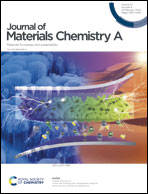A highly temperature- and pressure-sensitive soft sensor self-powered by a galvanic cell design†
Abstract
As mimics of human skin, soft sensors have profound implications for wearable electronics, biomedical diagnosis and environmental monitoring. However, the applications of soft electronic devices or soft sensors are limited by the integration of bulky external power supplies and low response sensitivity. Here, we report the use of water-saturated Ni2+- and Zn2+-containing elastomers consisting of interpenetrated carboxylated nitrile butadiene rubber (XNBR)/poly(N,N-dimethylacrylamide) (PDMA) networks and carbon nanotubes (CNTs) as electrolytes for assembling a self-powered polymeric soft sensor. The hydrophilic PDMA phases segregated by the XNBR phases in the polymer matrix acted as highly pressure-sensitive conductive paths, while the Arrhenius relationship between current density and temperature enabled a soft sensor with excellent temperature sensitivity. It can be used for the contactless detection of tiny temperature fluctuations and identification of sophisticated and tiny differences in human pronunciation and blood pulses. We also demonstrated the integration of the soft sensor arrays as an artificial skin for real-time monitoring of the variation in spatial distribution of pressure. The pixel-like sensor (5 × 5 mm2) had a maximum power consumption of only ∼5 μW. Our work provides new concepts and ideas for the fabrication of next-generation self-powered sensing devices for use in soft biomedical and wearable applications.



 Please wait while we load your content...
Please wait while we load your content...